“Saman Deviyo, who was present, appealed to the Buddha to leave behind a memento which they could venerate after the Buddha departed. The Buddha obliged by giving a few locks of hair (Kesa Dhatu) which were then deposited in a gold casket and enshrined in a stupa — the first to be built in Sri Lanka at the site of the Buddha’s visit.” –from the Mahavamsa
Introduction
The fourth instalment on my series on Buddhist pilgrimage trips in Sri Lanka (during February 2024) is about my visit to the place where the Shakyamuni Buddha was said to have first visited, Mahiyanganaya and taught the Dharma to quell a dispute. Mahiyangana is mentioned first in the ‘gatha’ recited to worship the ‘Solosmasthana’ — sixteen places revered by the visits of the Buddha.
Mahiyanganaya is a town situated close to the Mahaweli River in Badulla District, Uva Province of Sri Lanka. It is said that the Shakyamuni Buddha visited Mahiyanganaya on the Duruthu full moon day (nine months after his full awakening) to restore peace among the two main tribes in order to settle a dispute arose between Yakkas and Nagas (two tribes which then inhabited the area) and this was his first ever visit to Sri Lanka [1]. Foreseeing that the Dhamma would become established in Lanka, the Buddha came to dispel the yakkhas and preach to the devas. As he was about to leave, Samantha who had become a Stream Enterer, begged him to leave an object of worship and so the Buddha gave him a few hairs from his head.
On receiving the hairs Samantha, placed them in a golden urn and then enshrined them in a stupa of blue sapphire seven cubits high. With the ‘Parinirvana’ — the passing away of the Buddha — the collar bone relic was recovered from the funeral pyre and brought to Sri Lanka by Arahant Sarabhu and placed in the Mahiyangana stupa built over the original stupa. This, according to the legend, is the same stupa that we see today.
Moving from legend to history the Mahavamsa says that at the time of Devananpiyatissa, Prince Uddhaya Culabhaya enlarged the stupa making it 30 cubits high. Duttagamani enlarged it further and on orders from Vijayabahu I it underwent major renovations. Successive rulers, including King Dutugemunu in the 2nd Century BC and up to the present day, have improved upon the chethiya, covering it with layer after layer until it reached its present impressive proportions. Several of the kings of Kandy made pilgrimages to Mahiyangana. King Narendrasinghe went twice and King Virawickrama performed the whole pilgrimage on foot.
By the 19th century the stupa and most of the shrines around it were in a very dilapidated state and in 1949 a society was formed to restore it. The Department of Archaeology was invited to do a thorough investigation of the stupa before it was repaired. The relic chamber was opened and its walls were found to covered with paintings, their colours as fresh as if they had just been done. The paintings show the Buddha being tempted by Mara as he sits under the Bodhi Tree. Other paintings show Brahma, Siva, Vishnu and other devas. The relic chamber is thought to date from Vijayabahu’s renovations in the 11th century and has now been reassembled in the Anuradhapura museum.
There were no entrance fees and no tourists or foreigners to be seen when I arrived there. I was almost entirely alone there until the sun started to set and local devotees arrived. Being in such a deserted place of such a major pilgrimage site in Buddhist Sri Lanka it was also surprising how little development and infrastructure there was around the stupa. Nonetheless, it was a jewel of sacred beauty and wildlife. It had a simplicity and authenticity sometimes lacking at the bigger touristy sites, overrun with Instagram/selfie photo-grabbers and so on.
The energy of the place was also enduring. I arrived on a very warm, but cloudy and overcast day, yet at times, the sun peaked out from behind the clouds on the stupa when I was there. A deep peace and calm embraced it, as if the Buddha’s footprints and energy there bringing peace centuries ago, still lingered on.
This article shares information and my personal photos on how I travelled there from Kandy, the 18 hair-pin bend road, a huge Buddha statue next to the stupa, ancient tree and other sacred statues and sights. Sharing the beauty and blessings!
Music? Black is the Colour of my True Love’s Hair by Nina Simone.
Written and compiled by Adele Tomlin, 31st March 2024.
Getting to Mahiyangayana and the 18 hairpin bend road
After seeing the third place Buddha visited, Kelaniya, Kandy and the Dambulla Cave complex, I hired a rickshaw from Kandy to go to Mahiyanganaya. The trip took about one and a half hours from Kandy, and again was sweaty, hot even with the breeze. Mahiyangana is a Pali word (in Sinhalese ‘Bintenna’) which means flat land. It is situated eastwards to the steep eastern falls of central hills. The relative flatness of the area can be seen while traveling on the road from Kandy to Padiyathalawa across Hunnasgiriya and famous 18 hairpin bends. However, the backdrop to the flatland tea fields are spectacular, mystical hills.
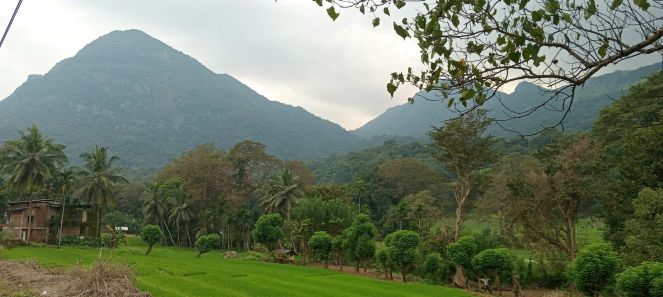


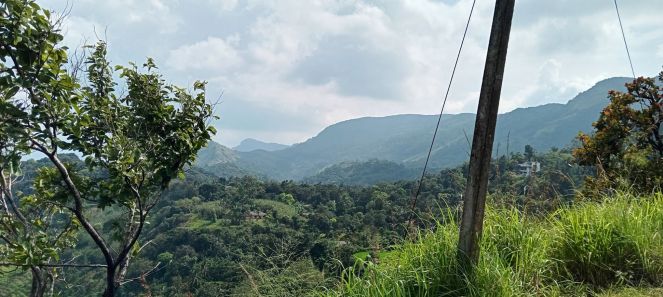

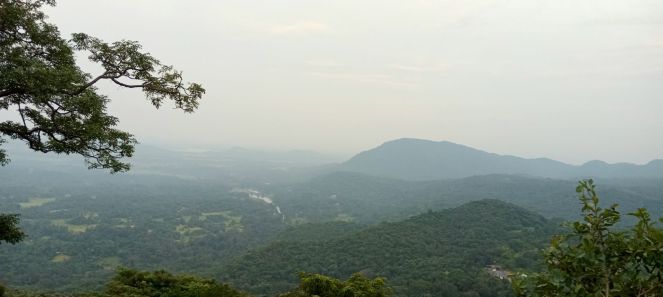
The 18 hairpin bends road was not as difficult or dangerous for drivers to drive on because it had recently been expanded. Below is an aerial shot of the road in 2021, which I found on the internet. The road has a length of 41km, including 18 hairpin bends.⠀The road has been improved (reasphalted and widened) the last years and links the cities of Kandy and Mahiyanganaya. It was feared by many drivers as one of the difficult roads in the country by many experienced motorists and became one of the roads to test their driving skills. But for more than one and a half centuries, this road was the only road that linked these main cities.

The views of the hills and lakes from the hairpin road were magical indeed, and photos do not do it justice.
The main ‘hair relics’ white stupa and temple grounds
When I arrived there it was almost deserted and I was the only foreigner. It was different to Kelaniya and Kandy, like a hidden gem unknown to to visitors passing through. There are two entrances, back and front, and the rickshaw driver dropped me off at the back, car parking area where there were mainly food stalls run by locals. I walked into the temple area, whose outer parts were not well-kept and immediately saw the huge white stupa. I started to circumabulate it and make offerings to the statues surrounding it. Here are some photos I took below:
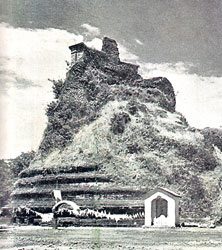
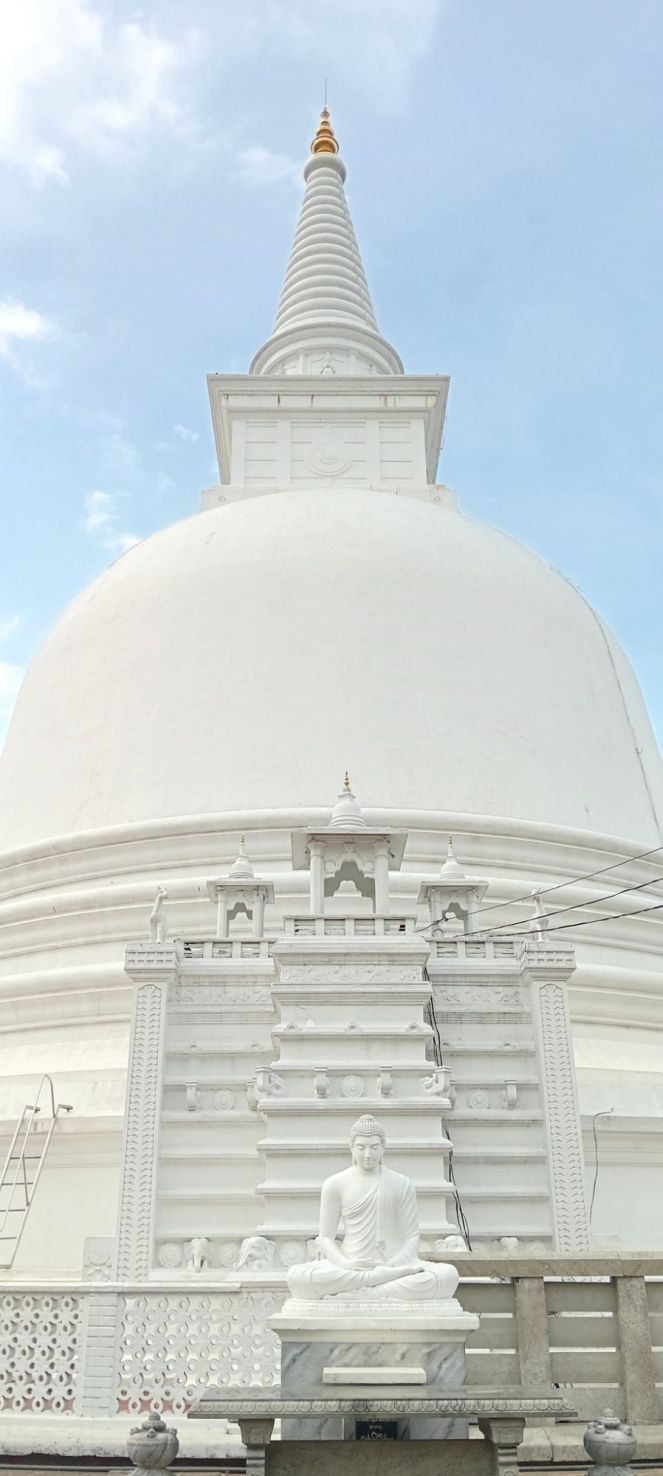






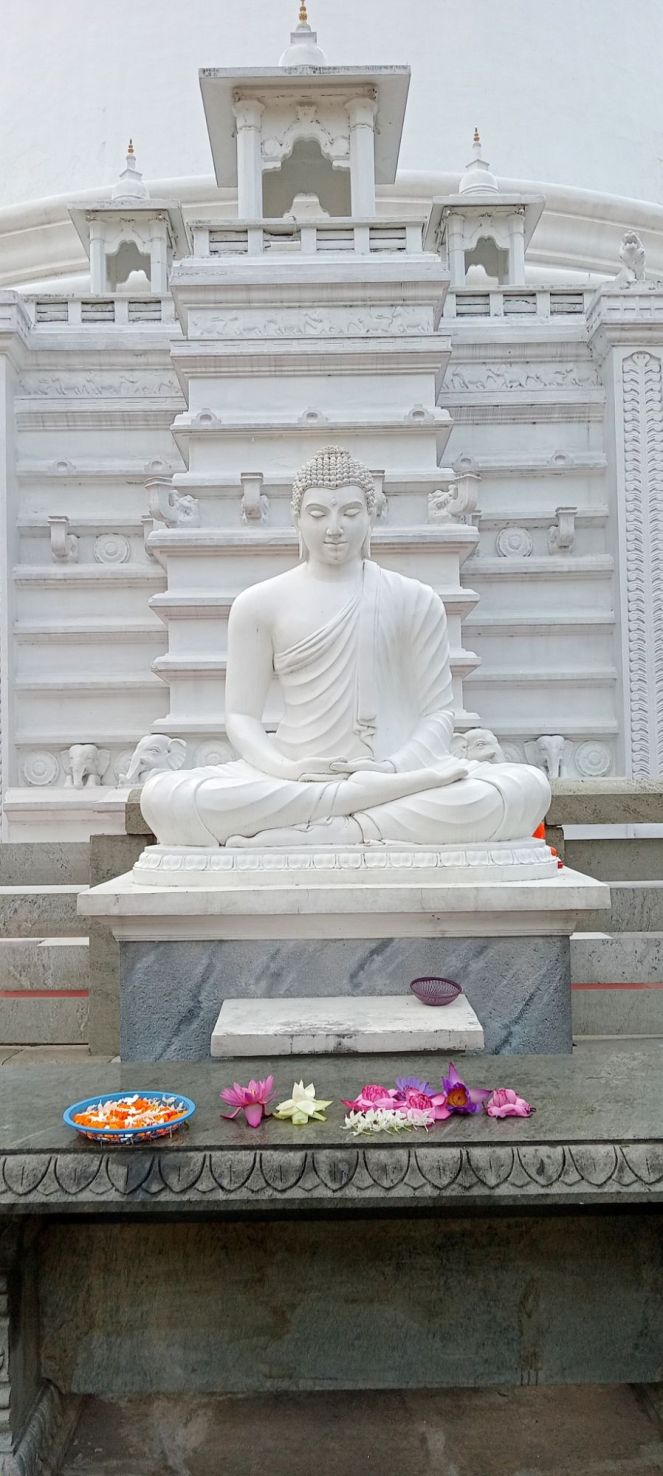

The external temple complex grounds/garden: elephant statues and exotic birds
As I walked away from the main stupa towards the front entrance gate, there were gardens and full of exotic birds and elephant statues and murals. It was lovely and there was a flock of birds there I have never seen in my life, and very unusual looking too, residing in the trees and grounds there (I have since discovered they are the Malabar Pied Hornbill, a common bird in Sri Lanka apparently). They were pecking at some rubbish people had left for food and swooping up into the trees when they felt nervous. See the photos below.



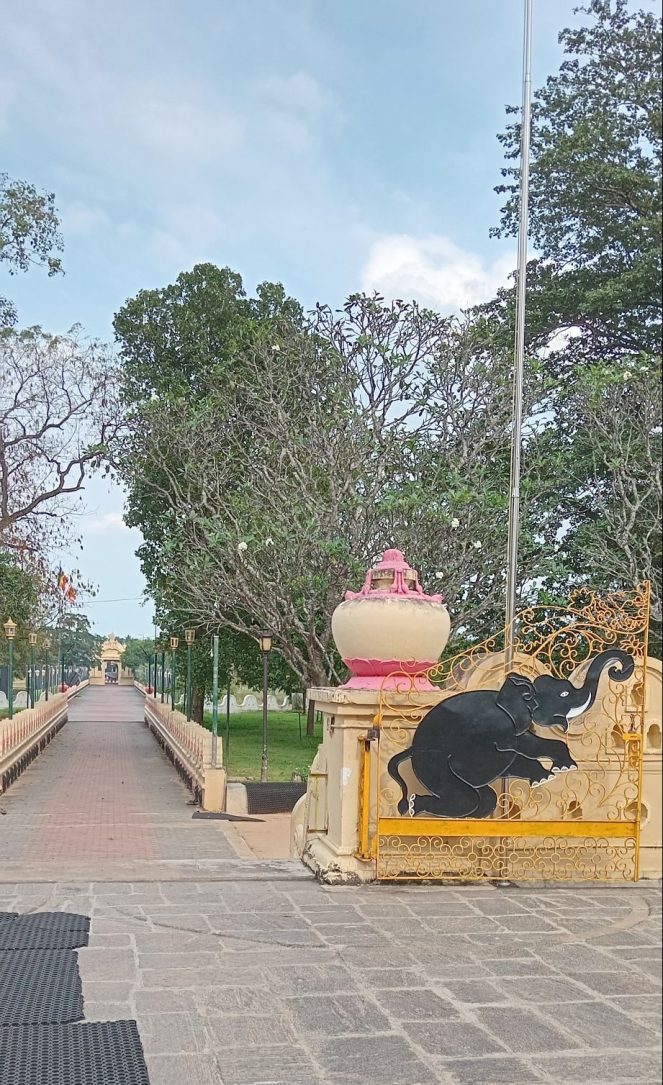

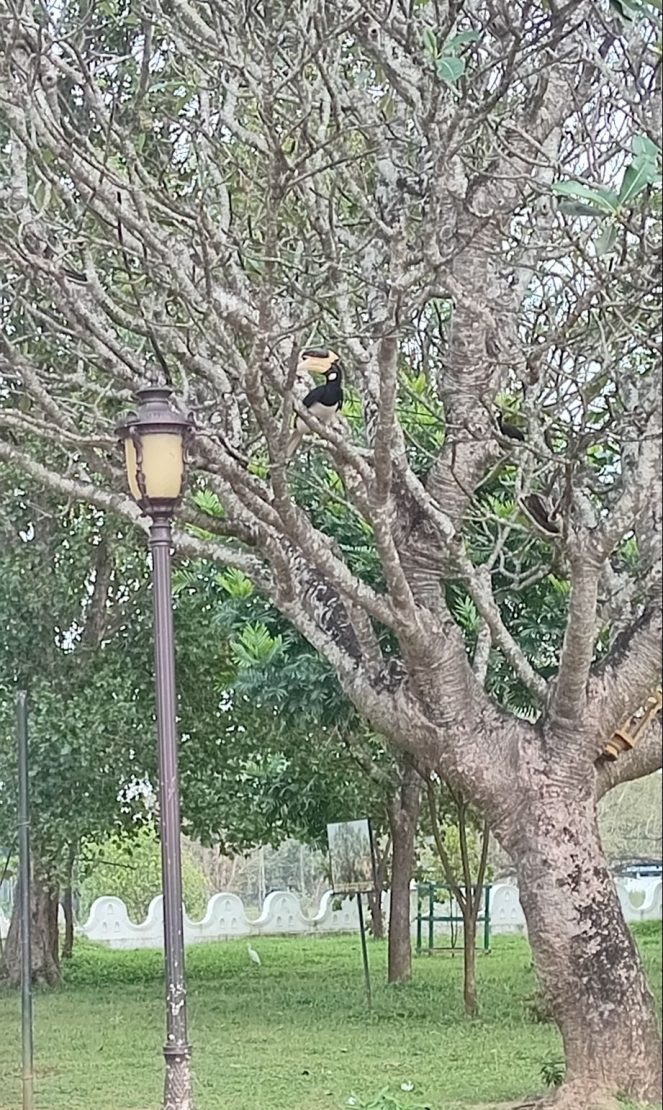

For a video I took of the unusual bird, see here:
The tallest Buddha statue in Sri Lanka
I then exited the main gate at the front and saw a huge standing white Buddha in the distance next to a lake. A stunning sight among the fields and hills. I walked over to it and circumambulated it and made offerings. The hills in the background were stunning and made me wonder if they had been like that even when Buddha was there.

This 102 feet tall standing Buddha statue in the’ travelling by air’ posture was built in the Seema Malaka premises of the Villuwa Lake reportedly as a concept of the founder of Meth Saviya organization, Professor Scientist Chandana Jayarathne, the Head of the Department of Physics, University of Colombo, on the instructions and guidance of the Most Venerable Urulewatte Dammasiddi Shri Attadassi Dammarakkithabhidhana thero, the Chief Prelate of the Shyamopalika chapter. For more information about the statue’s unveiling in 2023, see here.

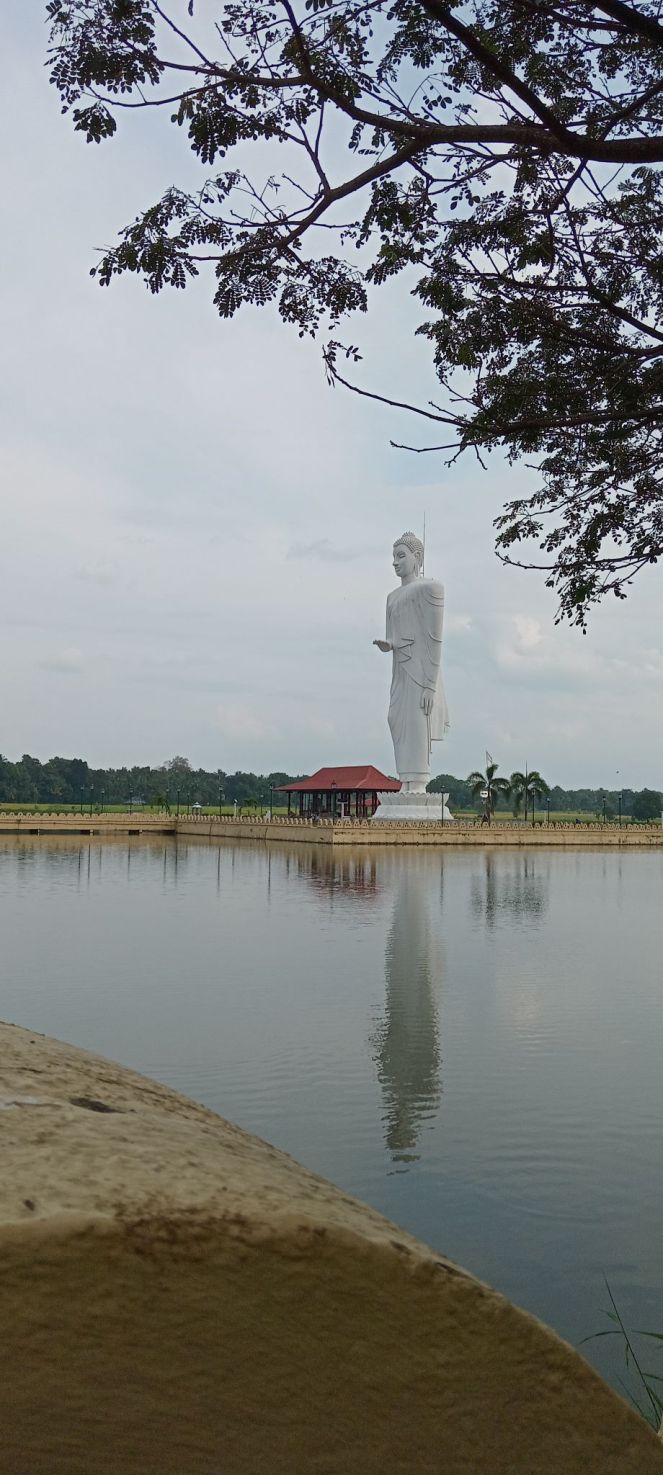
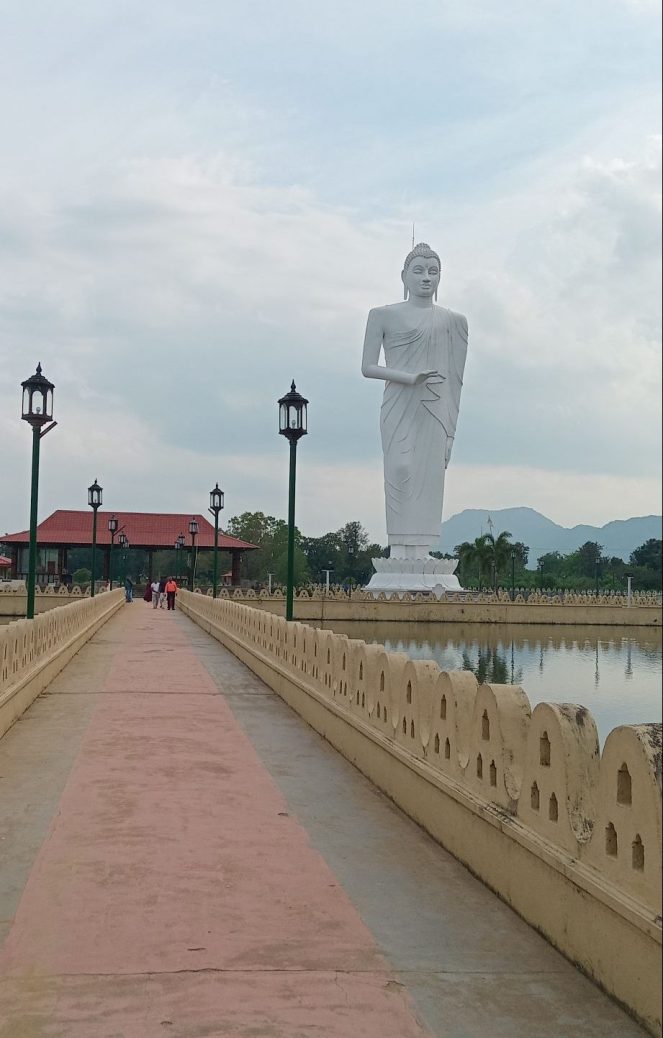
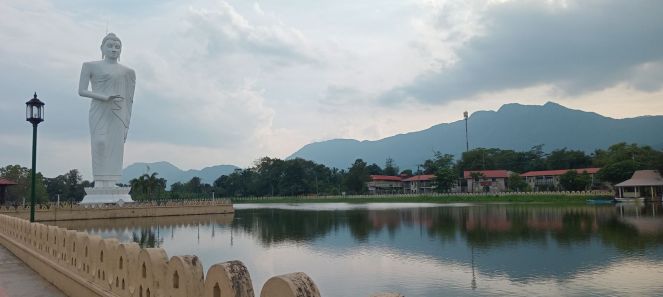



Sunset and a huge sacred tree spreading in all directions
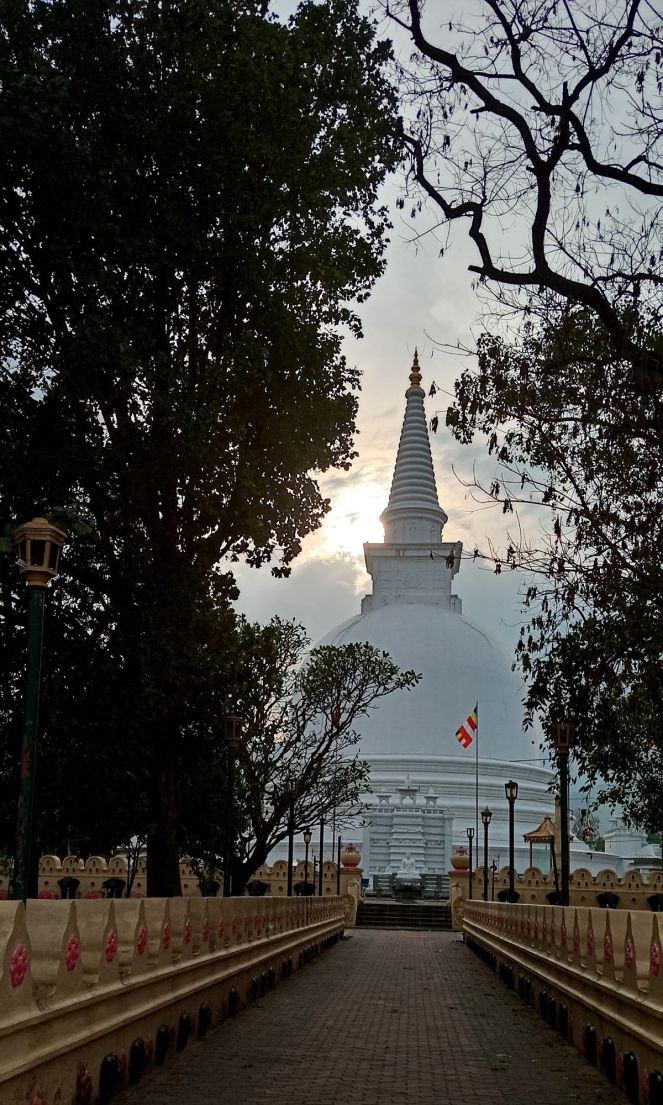

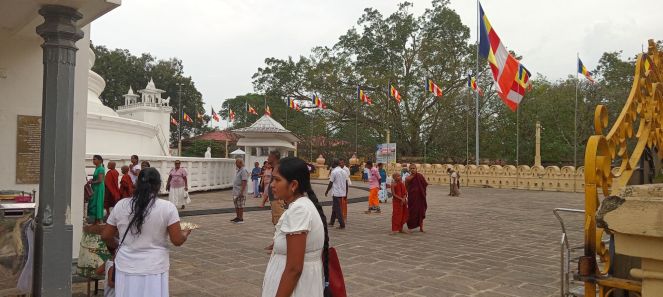
I walked back into the main temple area again. The day had been cloudy and overcast, but still hot. As I walked towards the main stupa, the sun started to come out from behind the clouds and the stupa. It was a stunning and warm experience and one that my camera could not capture well. It felt like the Buddha energy was shining on the stupa and myself. More people were coming to make offering and do circumambulations.
As I left the stupa, I saw a huge Bodhi tree in the grounds and saw that prayer flags had been draped around it and that it was protected (see photos). I wondered how old the tree was and its significance there.
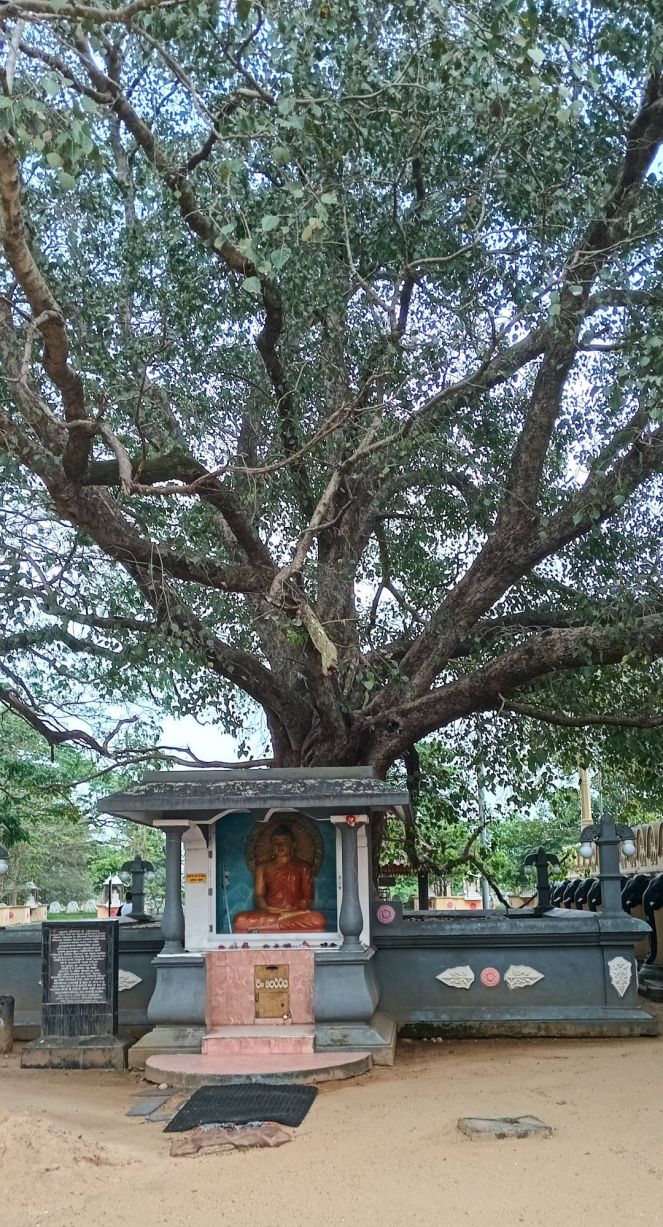

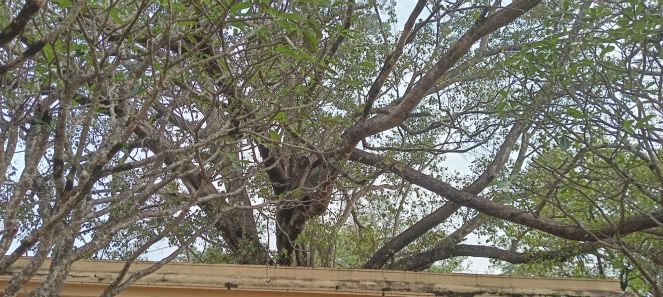
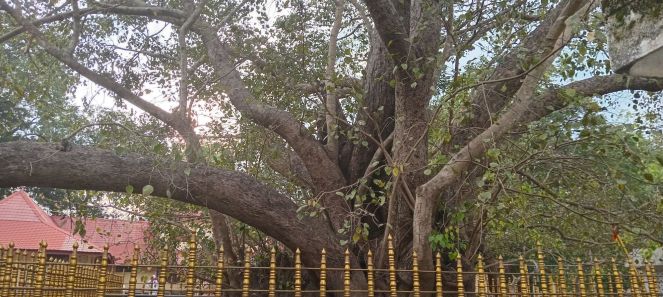
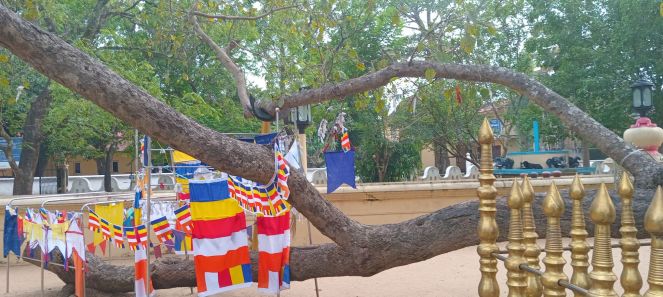

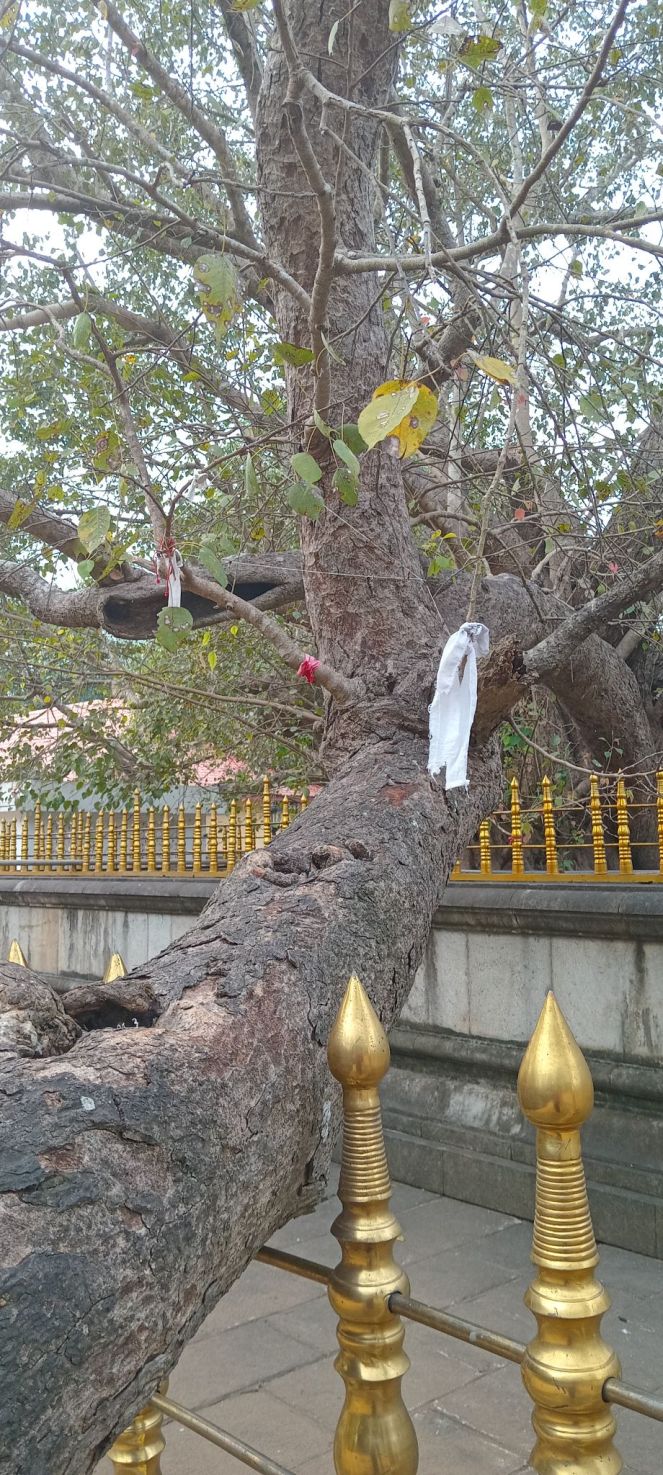


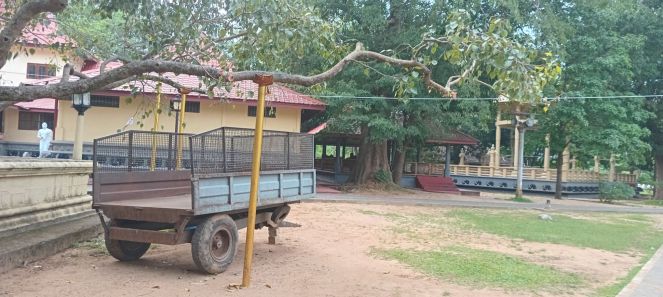

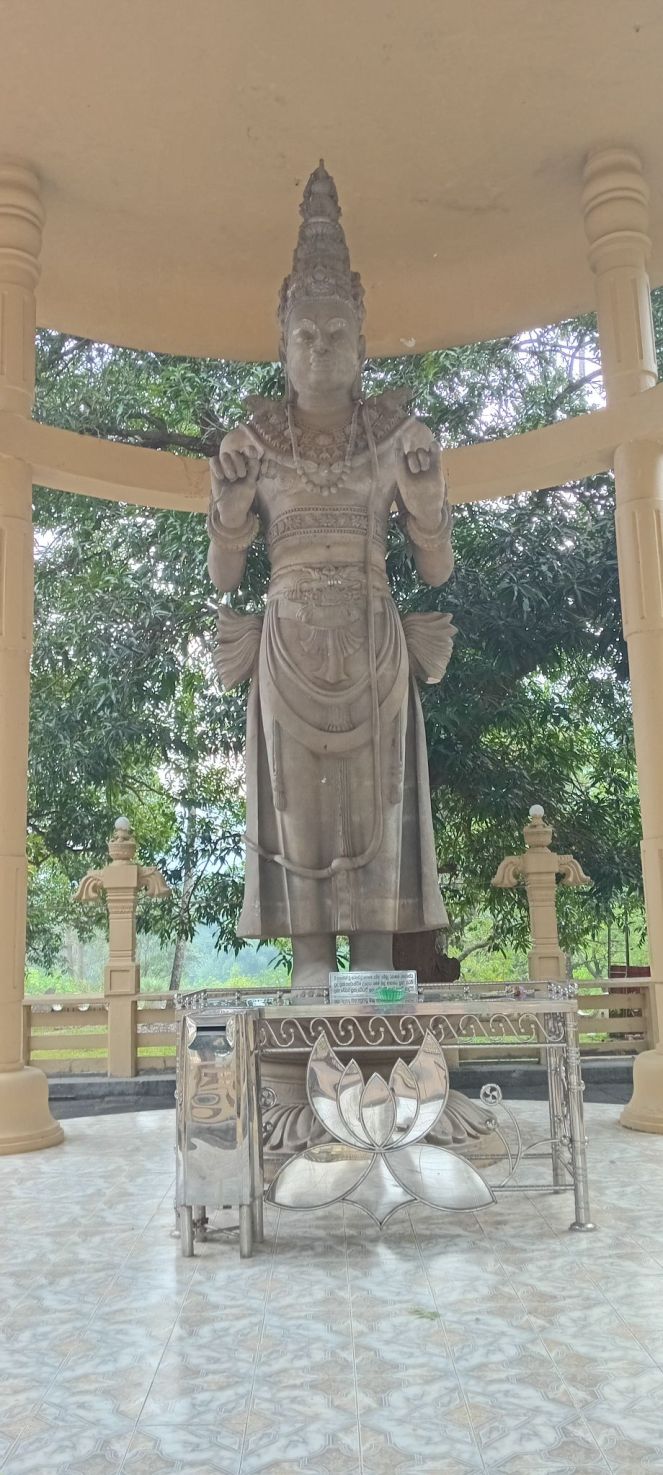
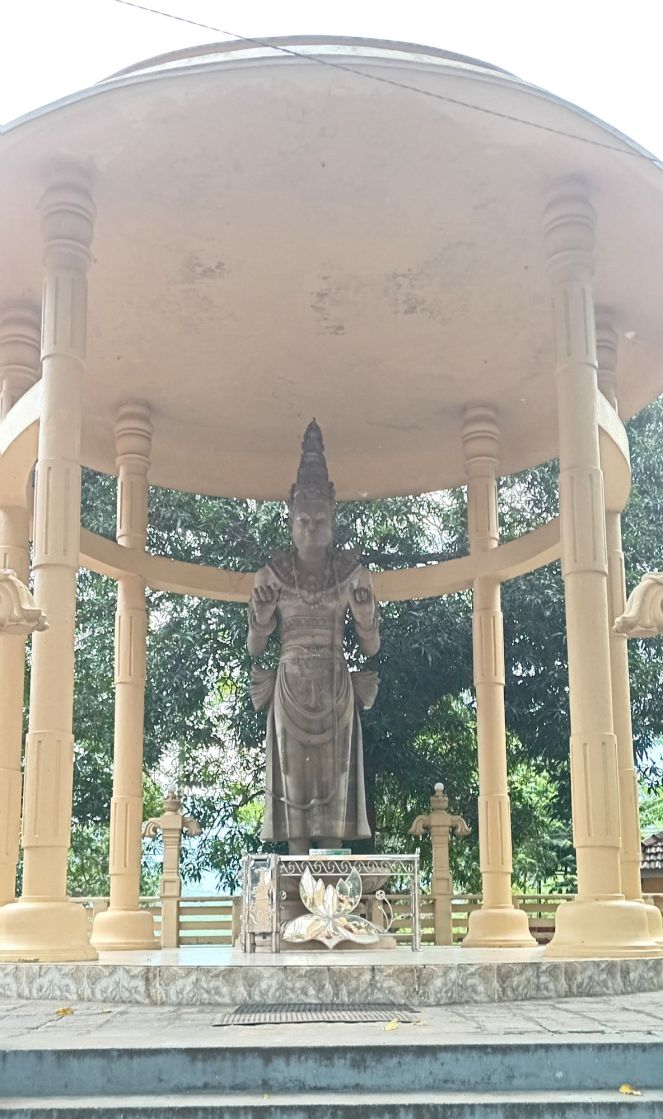
Endnotes
[1] The visit is recorded in the Great Chronicle Mahavamsa thus: “In the midst of Lanka, on the fair river bank, in the delightful garden three yojanas long and a yojana wide there was a great gathering of the Yakkhas dwelling in the island. To this great gathering of the Yakkhas went the Blessed One, and there, in the midst of that assembly, hovering in the air over their heads, he struck terror to their hearts by rain, storm, darkness and so forth. The Yakkhas, overwhelmed by fear, besought the fearless Vanquisher to release them from terrors.” The river bank referred to is that of Mahaweli River and the delightful garden has been identified as the Mahiyangana Mahanaga grove.
Not knowing who the stranger was, they thought he was an invader and took to arms to drive him away not allowing him to come down. The Buddha soon dispelled their fears and when they made way, the Buddha came down and preached to them. They were advised to shift to Giripada, possibly in the interior highlands.

